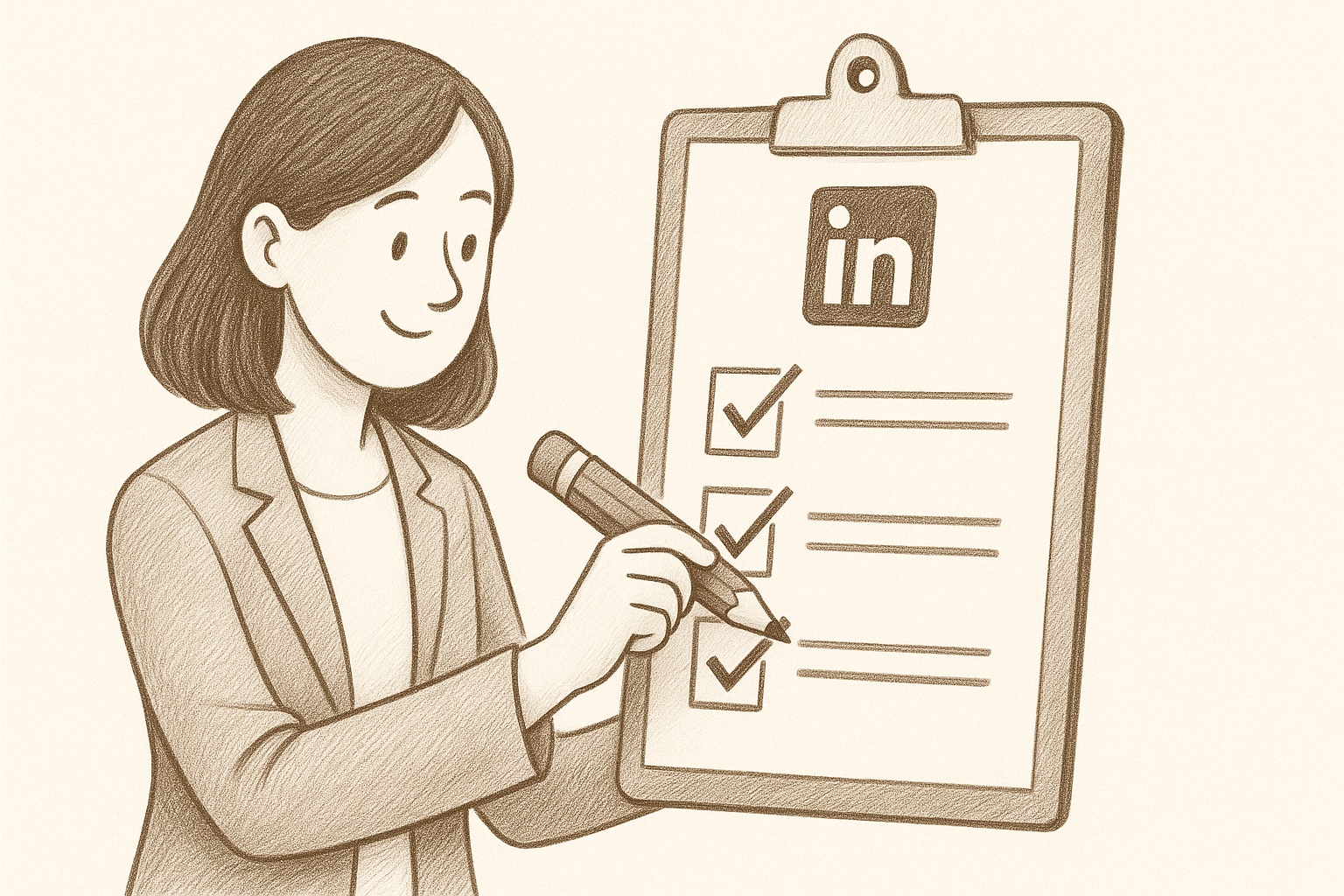17 LinkedIn Profile Tips That Actually Move the Needle for Founders

I’ve audited over 1,000 founder LinkedIn profiles, and 87% make the same fatal mistakes.
They treat LinkedIn like a digital resume instead of a sales tool. They focus on what they’ve done instead of what they can do for others. They optimize for their ego instead of their customer’s needs.
The result? Invisible profiles that generate zero business value.
But the founders who get it right? Their profiles become lead generation machines that work 24/7, attracting customers, partners, and opportunities without any paid advertising.
After analyzing the highest-performing founder profiles and implementing these strategies across thousands of LinkedIn users, I’ve identified the 17 profile tips that actually move the needle.
These aren’t generic “use a professional headshot” suggestions. These are battle-tested tactics that turn profiles into pipeline.
TIP 1: Lead with Outcomes, Not Titles
The mistake: “CEO at TechCorp | Entrepreneur | Thought Leader”
The fix: Start your headline with the transformation you create.
Examples that work:
- “Helping B2B SaaS Cut Customer Acquisition Cost 40% | CEO @ GrowthCorp”
- “Turning Manual Processes into Automated Profit Centers | Founder @ AutoFlow”
- “Scaling E-commerce Brands from $1M to $10M+ | Forbes 30 Under 30”
Why it works: Prospects care about outcomes, not your job title. Leading with results immediately communicates value.
Implementation: Complete this sentence: “I help [specific audience] achieve [specific outcome].” Put that at the beginning of your headline.
TIP 2: Use Your Cover Photo as a Billboard
The mistake: Leaving the cover photo blank or using a generic company logo.
The fix: Create a visual value proposition that reinforces your headline.
High-impact cover photo ideas:
- Customer success metrics with compelling visuals
- Your core methodology or framework illustrated
- Social proof compilation (logos, testimonials, press mentions)
- Before/after transformations you’ve facilitated
- A clear call-to-action directing people to your lead magnet
Pro tip: Include your contact information or website URL in the cover photo for easy access.
TIP 3: Open Your About Section with a Problem Hook
The mistake: Starting with your background or credentials.
The fix: Open with a problem your ideal customer faces daily.
Problem hook examples:
- “Most B2B companies lose 25% of their customers every year and don’t even know it’s happening.”
- “E-commerce brands spend thousands on traffic but convert less than 2% into customers.”
- “SaaS founders know they need better onboarding but don’t know where to start.”
Why it works: Starting with a problem immediately signals relevance to people facing that exact challenge.
Implementation: Identify the #1 problem you solve and open your About section by describing it specifically.
TIP 4: Include Specific Metrics in Your Experience
The mistake: “Responsible for managing sales team and increasing revenue.”
The fix: Quantify every achievement with specific metrics.
Metric-rich examples:
- “Built and led 12-person sales team that grew ARR from $2M to $15M in 18 months”
- “Implemented customer success program that reduced churn from 8% to 3.2%”
- “Launched partnership program generating 40% of company revenue within 24 months”
Golden rule: If you can’t measure it, it doesn’t belong on your profile.
TIP 5: Use Keywords Like Your Customers Do
The mistake: Using internal company jargon or technical terms.
The fix: Research how your ideal customers describe their problems and use their language.
Keyword research process:
- Analyze your customers’ LinkedIn profiles
- Note the language they use to describe challenges
- Look at what they post about and engage with
- Include these exact terms in your profile
Example: Instead of “Customer Journey Optimization,” use “Customer Experience” if that’s how your audience talks about it.
TIP 6: Feature Customer Results, Not Company Features
The mistake: Listing what your product does instead of what customers achieve.
The fix: Transform every feature into a customer outcome.
Feature → Outcome transformations:
- “AI-powered analytics platform” → “Marketing teams identify their best campaigns 5x faster”
- “Automated workflow management” → “Operations teams eliminate 67% of manual tasks”
- “Customer success platform” → “SaaS companies reduce churn by an average of 43%”
Implementation: For every capability you mention, follow it with “which helps customers [specific outcome].”
TIP 7: Create Featured Content That Captures Leads
The mistake: Using Featured section for random company content.
The fix: Showcase valuable resources that capture contact information.
Lead-generating Featured content:
- Industry-specific calculators or assessment tools
- Comprehensive guides solving specific problems
- Case studies with downloadable detailed analysis
- Templates and frameworks you use internally
- Video tutorials providing immediate value
Pro tip: Each Featured item should provide value while positioning you as the expert.
TIP 8: Write Recommendations That Build Your Brand
The mistake: Generic recommendations that could apply to anyone.
The fix: Give recommendations that showcase your expertise and judgment.
Strategic recommendation approach:
- Highlight specific results you helped them achieve
- Demonstrate your knowledge of their industry/challenges
- Position yourself as someone who recognizes talent
- Include metrics and concrete outcomes when possible
Example: “Sarah increased her team’s productivity by 60% after implementing the framework we developed together. Her ability to translate complex processes into simple systems is exactly what growing companies need.”
TIP 9: Use Skills Section for Search Optimization
The mistake: Listing random skills without strategy.
The fix: Include skills your ideal customers search for when looking for solutions.
Strategic skills optimization:
- Research what skills your target customers have listed
- Include skills they would search for when seeking help
- Get endorsed by credible people in your network
- Regularly update based on market trends
Example: If you help marketing teams, include “Growth Marketing,” “Customer Acquisition,” “Marketing Automation”—not just “Leadership” and “Strategy.”
TIP 10: Optimize for Mobile Viewing
The mistake: Creating a profile that only looks good on desktop.
The fix: Ensure every element works perfectly on mobile devices.
Mobile optimization checklist:
- Profile photo is clear and recognizable at small sizes
- Headline is compelling in first 120 characters
- About section uses short paragraphs for easy scanning
- Contact information is clickable on mobile
- Featured content loads quickly and displays properly
Pro tip: Test your profile on multiple mobile devices regularly.
TIP 11: Include a Clear Call-to-Action
The mistake: Ending your About section without telling people what to do next.
The fix: Include a specific, low-commitment call-to-action.
Effective CTA examples:
- “DM me ‘GROWTH’ for our founder’s toolkit (free)”
- “Download our SaaS metrics calculator in the Featured section”
- “Book a 15-minute growth audit: [calendar link]”
- “Connect if you’re scaling a B2B company and want to share experiences”
CTA optimization: Make it specific, valuable, and easy to take action on.
TIP 12: Update Your Profile Regularly
The mistake: Setting up your profile once and forgetting about it.
The fix: Treat your profile as a living document that evolves with your business.
Regular update schedule:
- Monthly: Review and refresh recent activity and posts
- Quarterly: Update achievements, metrics, and focus areas
- Annually: Complete profile overhaul based on business evolution
What to update:
- Recent wins and customer results
- New services or focus areas
- Updated metrics and achievements
- Seasonal relevance and current priorities
TIP 13: Use Rich Media Strategically
The mistake: Adding media just because you can.
The fix: Include media that demonstrates expertise and builds credibility.
High-impact media types:
- Screen recordings showing your product solving real problems
- Customer testimonial videos
- Speaking engagement highlights
- Behind-the-scenes content that builds authenticity
- Data visualizations that demonstrate results
Quality over quantity: Three compelling pieces of media beat ten mediocre ones.
TIP 14: Leverage Social Proof Throughout
The mistake: Burying credentials at the bottom of your profile.
The fix: Weave social proof naturally throughout your entire profile.
Social proof integration points:
- Headline: Include recognizable credentials or results
- About section: Mention press coverage, customer results, recognition
- Experience: Include partnership with notable companies
- Featured section: Showcase testimonials and press mentions
- Recommendations: Strategic requests from notable industry figures
Principle: Social proof should feel natural, not forced.
TIP 15: Write for Your Audience, Not Yourself
The mistake: Using language that makes you feel smart instead of language that helps customers understand.
The fix: Write everything from your ideal customer’s perspective.
Customer-centric language:
- Use “you” more than “I”
- Address their challenges before your solutions
- Explain benefits in terms they understand
- Avoid jargon they wouldn’t use
Test: Have someone from your target audience read your profile. If they don’t immediately understand how you help people like them, rewrite it.
TIP 16: Connect Your Profile to Your Sales Process
The mistake: Treating your profile as separate from your sales funnel.
The fix: Integrate your profile into your broader customer acquisition strategy.
Profile-to-sales integration:
- Link to landing pages designed for LinkedIn traffic
- Reference your profile content in sales conversations
- Use profile insights to inform prospect research
- Track which profile elements generate the most qualified leads
Implementation: Create a dedicated landing page for LinkedIn visitors that acknowledges they came from your profile.
TIP 17: Analyze and Optimize Based on Data
The mistake: Making profile changes based on gut feel instead of performance data.
The fix: Track specific metrics and optimize based on results.
Key metrics to track:
- Profile views from target audience segments
- Connection acceptance rates from ideal prospects
- Click-through rates on Featured content
- Message response rates after profile visits
- Business outcomes attributed to profile optimization
Optimization process:
- Establish baseline metrics
- Make one change at a time
- Measure impact over 2-4 weeks
- Keep what works, discard what doesn’t
- Test continuously
IMPLEMENTATION FRAMEWORK: The 30-Day Profile Transformation
Week 1: Foundation Fixes
- Day 1-2: Rewrite headline using outcome-focused approach
- Day 3-4: Create problem-hook opening for About section
- Day 5-7: Update all experience sections with specific metrics
Week 2: Visual and Content Optimization
- Day 8-10: Design and implement strategic cover photo
- Day 11-12: Create and upload valuable Featured content
- Day 13-14: Optimize skills section for search visibility
Week 3: Social Proof and Integration
- Day 15-17: Request strategic recommendations
- Day 18-19: Add rich media that demonstrates expertise
- Day 20-21: Integrate clear calls-to-action throughout profile
Week 4: Testing and Optimization
- Day 22-24: Test mobile optimization across devices
- Day 25-27: Set up tracking and measurement systems
- Day 28-30: Analyze initial results and plan ongoing optimization
INDUSTRY-SPECIFIC PROFILE TIPS
B2B SaaS Founders
Focus on: Growth metrics, customer retention, product-market fit demonstrations Language: Technical enough for credibility, simple enough for business leaders Social proof: Customer logos, ARR growth, investor recognition
E-commerce Founders
Focus on: Revenue growth, customer experience, brand building achievements Language: Results-oriented, customer-centric, growth-focused Social proof: Sales figures, brand partnerships, customer testimonials
Professional Services Founders
Focus on: Client transformations, industry expertise, thought leadership Language: Professional but approachable, expertise-demonstrating Social proof: Client results, industry recognition, speaking engagements
FinTech Founders
Focus on: Security, compliance, financial outcomes, innovation Language: Trust-building, technically accurate, benefit-focused Social proof: Regulatory approvals, security certifications, adoption metrics
COMMON PROFILE MISTAKES TO AVOID
The Humility Trap
Mistake: Being too modest about achievements Fix: Confidence attracts customers; false modesty repels them
The Feature Factory
Mistake: Listing what you do instead of outcomes you create Fix: Every feature mentioned should be tied to a customer benefit
The Generic Professional
Mistake: Sounding like every other founder in your space Fix: Highlight what makes your approach unique and different
The Information Overload
Mistake: Including too much information without clear hierarchy Fix: Use the “3-second rule”—can someone understand your value in 3 seconds?
HOW GREENROOM ENHANCES YOUR PROFILE IMPACT
A great profile attracts prospects, but systematic follow-up converts them into customers.
Where Greenroom helps:
- Visitor tracking: Identify who’s viewing your optimized profile
- Engagement automation: Follow up with profile visitors systematically
- Content amplification: Ensure your valuable Featured content reaches the right people
- Conversion optimization: Turn profile visits into business conversations
The goal is to create a complete system where your optimized profile attracts prospects and automation helps convert them into customers.
YOUR PROFILE SUCCESS MEASUREMENT
Track these metrics to understand your profile’s business impact:
Leading indicators:
- Profile views from target customer segments
- Connection requests from ideal prospects
- Engagement with Featured content
- Click-through rates to your website
Lagging indicators:
- Demo requests mentioning your profile
- Sales conversations initiated through LinkedIn
- Partnership opportunities from profile visibility
- Team members recruited through LinkedIn
ROI calculation: If your optimized profile generates 5 additional qualified leads per month and your close rate is 20% with $25,000 average deal size, that’s $25,000 monthly revenue directly attributable to profile optimization.
YOUR NEXT STEPS
Don’t try to implement all 17 tips at once. Start with these five high-impact changes:
- Rewrite your headline with outcomes instead of titles (Tip 1)
- Add a problem hook to your About section opening (Tip 3)
- Include specific metrics in your experience descriptions (Tip 4)
- Create valuable Featured content that captures leads (Tip 7)
- Add a clear call-to-action that tells people what to do next (Tip 11)
Implement these five changes over the next two weeks, then measure the impact before adding more optimizations.
Remember: Your LinkedIn profile is your always-on sales representative. Make sure it’s representing you well.
The difference between an average profile and an exceptional one isn’t talent or luck—it’s knowing which details actually matter and implementing them systematically.
Your expertise deserves to be discovered by the people who need it most. These 17 tips ensure it will be.
Dom from Greenroom
Dom is the founder of Greenroom, a LinkedIn automation platform that helps entrepreneurs and sales professionals scale their outreach. He's helped thousands of professionals grow their LinkedIn presence and generate founder-led sales.


